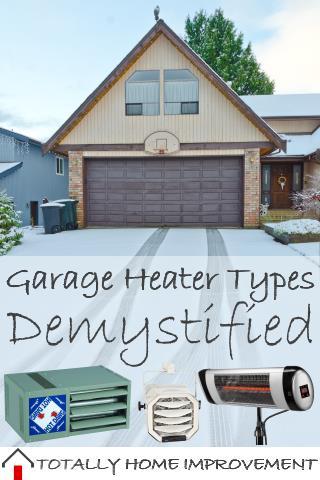
Why It's Important To Understand Garage Heater Types
Selecting the most appropriate garage heater for your circumstances isn't as straight-forward as you might think due to different types having different safety issues, regulatory requirements, installation costs and operating costs, and that's without even considering different levels of effectiveness in various garages and the different things people use their garage/workshops for.
This guide provides a straight-forward explanation of the types of garage heaters suited to a residential garage or workshop, and provides recommendations on which types are typically most effective in different situations.
Contents
- How Garage Heaters Are Classified
- Heating Technology Types:
- Operating Power / Fuel Types:
- Mounting Options
- Additional Garage Heater Resources
How Garage Heaters Are Classified
Although there are no universal classification rules (some online retailers add many more terms to their heater titles), typically a garage heater's type is stated as being a combination of its Heating Technology, main Mounting Option, and its Power Source.
Here are some examples of garage heater types:
- Radiant Electric Portable Heater
- Convection Gas Ceiling Heater
- Forced-Air Electric Ceiling Heater
If you're not yet familiar with the terminology above, don't worry, it's not hard to understand and it's all explained below.
Heating Technology Types
There are three main heating methods used by garage heaters and each one has its particular set of characteristics, pros and cons that you'll need to be aware of.
-
Radiant / Infrared
Radiant heaters are also called Infrared heaters because they radiate Infrared light that heats the objects it 'shines' on.
Their main drawback is that they essentially don't heat the air and don't directly heat anything that isn't in a direct line-of-sight to the heater's radiator. Although, objects in the radiator's 'shadows' may receive some heating from reflected and re-radiated heat from other objects or surfaces such as the walls and floor.
Their infrared light is subject to the inverse-square law which means that objects that are twice as far away from the radiator as other objects will only receive one quarter of the amount of radiated energy.
The bottom line is that radiant heaters produce different levels of heating around your garage and leave the air pretty much as cold as it was before you turned the heater on.
If for some reason your garage isn't closed off, such as having a front door that has to stay open as they sometimes do in commercial workshops, then a radiant heater will be much more effective than the other options which rely on circulating air to distribute the heat.
Recommended for:
Garages that aren't fully enclosed or are poorly sealed meaning that significant amounts of heated air will leak out. They can also be a good option if you want to be able to use it both in the garage and outside, although in this case you may be better served with an outdoor radiant heater. -
Convection
These directly heat air and tend to produce a more evenly distributed heating effect throughout the garage than radiant heaters do.
When air is heated it becomes less dense than the surrounding cooler air and floats up toward the ceiling. This causes cooler air to be 'sucked' toward the heater which then also gets heated and rises away. This produces a circulating current of air which is being continually driven by temperature differences - this is what the word convection means.
Convection air currents produce less dramatic temperature differences around the garage than those caused by radiators. You will still get 'cold spots' caused by objects that interfere with the air currents, and further away from the heater will still be cooler due to the warm air mixing with cold air as it circulates, but the temperature differences will be less dramatic and less 'spotty' than you typically get from radiant heaters.
Although convection heaters theoretically use a bit less energy than forced-air heaters, I have noticed in home improvement forums that quite a few people with convection heaters also end up getting a fan to better circulate the heated air, which means they end up using just as much, if not more, power than they would if they only used a forced-air heater in the first place.
Recommended for:
Well sealed and insulated smaller garages (1 to 2 parking spaces) where the modest convection currents will be sufficient to circulate warm air throughout. -
Forced-Air / Fan-Forced
Forced-Air heaters use a fan to blow the heated air so they're also commonly referred to as being Fan-Forced.
These also heat air directly as a convection heater does, but instead of relying on convection to gently circulate heated air, they blow it around the room.
By forcing the heated air to move around the garage they produce a more even heating effect than the options above and tend to work better in larger garages with the equivalent of 2 or more parking spaces.
Their downside is that they theoretically use slightly more energy than the two options above because they do the additional work of forcing the heated air to move. But in practice you may find that you don't have to drive them as hard as other options to get the whole garage feeling comfortable due to the way they more effectively distribute the heated air throughout your working environment. Perhaps this is why highly experienced people who work in the field argue over whether or not Forced-Air heaters actually do cost more to run - some say they don't.
Recommended for:
Garages, large or small, that are reasonably well sealed.I've used all three types of heaters, and in my opinion forced-air heaters typically provide a much more comfortable working environment.
Operating Power / Fuel Types
There are two main types of energy sources used by residential garage heaters and each can be further divided into sub-categories. I won't further break down the electric category because the other types of electrical systems I could mention (like DC or 3 phase power) don't apply to most people in a residential context.
-
Electricity
Electric heaters are by far the simplest to install, maintain and operate, for reasons that you'll see when you read the fossil fuel options below. So, unless you're like my brother who lives on a farm and has a non-standard 48V DC solar power system, then you can just buy, install and start using a domestic electric garage heater with nothing else to worry about (assuming you don't need any electrical wiring work done).
Recommended for:
Almost everyone - this is potentially the most environmentally responsible option (depending on your electricity supply), it's the most reliable for those connected to the electrical grid, they don't cause annoying or dangerous fumes, and there are no flames to provide an ignition source for people who work with volatile substances. -
Fossil Fuels / Hydrocarbons
This is where different safety requirements, complexity of installation, and regulations become important, so we'll look at the two main sub-types separately.
However there is one issue that all hydrocarbon burning appliances have in common, and that is the danger of malfunctions in the appliance, ducting or venting systems which result in being exposed to dangerous carbon monoxide levels. The only safe way to operate any fuel burning appliance in an enclosed space is to have a Carbon Monoxide Detector to quickly warn you if something goes wrong. Most states have laws requiring them, but don't waste your time reading legal documentation and just get one for your garage if you get a fuel burning heater.
Propane and Kerosene
These fuels are typically used by portable heaters and are tend to be the less expensive ones to buy.
If you have a medical respiratory condition, or if you're sensitive to petrochemical fumes, then you should avoid these types of fuel because some heaters burning them will produce irritating fumes even when working correctly.
The CDC advises not to use fossil fueled appliances in an enclosed space without adequate ventilation. Unfortunately, the most practical ventilation for a portable heater is to leave a door open which tends to let in all the cold air that you're trying to avoid.
The advantages of heaters using these fuels is typically in their lower prices and their high degree of portability.
Important: Do not use a liquid fueled heater inside if the manufacture's instructions say it is designed for outdoor use only because these heaters are likely to produce unsafe levels of carbon monoxide.
Recommended for:
These can be quite useful if you want your garage heater to be both portable and not dependent on having electricity supplied - this is particularly true for ones employing radiant heating because they are quite effective when used outside.Natural Gas
Gas garage heaters are the most complicated to install, and even if you don't need to hire a contractor to do the work, you will almost certainly have local codes to adhere to and probably also have to have a formal inspection done. The relevant rules and regulations vary so much from place to place that I won't provide any advice beyond urging you to contact your local authorities (usually your town or city municipality) to find out what your local requirements are before you buy a gas heater or start the installation process.
The reason gas powered appliance installations are subject to regulations is because people can (and do) die as a result of sub-standard work with carbon monoxide poisoning being one of the major risks. The CDC says on their website, "During 2010–2015, a total of 2,244 deaths resulted from unintentional carbon monoxide poisoning, with the highest numbers of deaths each year occurring in winter months". The peak death rate in winter is simply because more fossil fueled heaters are used indoors at this time of year.
Natural gas garage heaters are typically the most expensive type to have professionally installed (I strongly recommend against non-qualified DIYers doing gas installations for safety reasons, but not hiring a professional can also void your warranty), but if you already have gas at your home then it might be the cheapest to operate in your situation.
The reason I say natural gas 'might' be cheaper is because although it is a cheaper source of energy in many places at the moment, it's very difficult to predict where energy prices will go over the life of your heater - I'm placing my personal bet on fossil fuels going up in price and non-fossil fueled electricity coming down over the next 10 years, but I'm just making a moderately informed guess.
Recommended for:
Permanent installation where your home already has natural gas supplied. You can also run some natural gas models on LPG after buying an LP conversion kit.
Mounting Options
This is the easiest aspect to understand and doesn't require a lot of explanation. The main options you will see are:
- Portable
- Ceiling
- Wall
It's worth noting that some portable heaters can be stand mounted so you might see some described with the word 'stand' rather than 'portable'.
Additional Garage Heater Resources
Now that you have a good understanding of the various types of garage heaters and what they do, you may want more information specific to your situation, so you should find these extras quite helpful.
- What Size Heater Do I Need For My Garage?
- Helpful Garage Heater Installation Tips
- How to Reduce the Energy Costs of Your Garage Heater
- Video: How To Install a Hard-Wired 220V Electric Garage Heater
- Video: How To Install a 220V Electric Garage Heater plugged into a Dryer Socket
- Video: How To Install a Ceiling Mounted Vented Gas Heater in Your Garage
You might also like to read:
• Tips On How To Keep Your Garage Tidy & Well Organised
• An Overview of the Different Types of Home Insulation
• Outdoor Radiant Heaters
Category:



